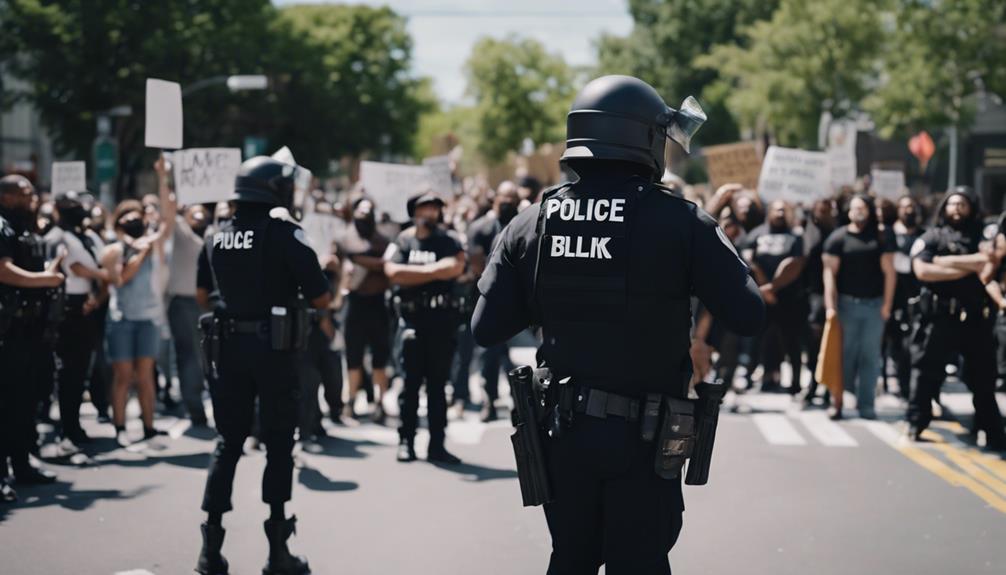Uncovering the truth about BLM protests reveals their fight against long-standing injustices. Similar to the Civil Rights Movement, BLM brings attention to racial disparities. Violent confrontations aim to bring to light systemic racism, although there are criticisms about their effectiveness. Martin Luther King Jr. used similar tactics strategically to advance civil rights. Violence, as a catalyst for societal progress, has historically brought about change. A more nuanced perspective emerges by examining the origins and impact of BLM protests. Understanding the historical context is crucial in grasping the movement’s objectives and obstacles. Further exploration is needed to fully understand the complexities of this significant movement.
Key Takeaways
- BLM protests expose systemic racism and police brutality.
- Media may sensationalize violence, overshadowing peaceful demonstrations.
- Misrepresentation in media can distort public perception of BLM.
- Historical context of racial discrimination informs current activism.
- Learning from history guides actions towards social justice.
Historical Parallels Between BLM and Civil Rights
During the turbulent times of the Civil Rights Movement, parallels can be drawn to the challenges faced by the Black Lives Matter movement today. Both movements encountered strong opposition from the majority of Americans, critiquing their methods and goals. Martin Luther King Jr., a key figure in the Civil Rights Movement, deliberately sought out confrontations to bring attention to racial injustices, a strategy that the Black Lives Matter movement has also utilized.
The Children's Crusade, where black children marched in Birmingham, resulted in violent police attacks, highlighting the substantial impact of racial discrimination.
Public opinion towards both movements has been divided, with some acknowledging the necessity of such actions to challenge the racial status quo, while others criticize the use of violence. However, the influence of these movements is evident, as they've significantly shaped societal perceptions and brought about much better understanding of the enduring struggles faced by African Americans in the fight for equality and justice.
Violent Confrontations for National Attention

Engaging in violent confrontations during BLM protests has been a strategic method to capture national attention and underscore the pervasive racial injustices within America. These confrontations aimed to dramatize issues and amplify the urgency of addressing systemic racism in the country.
Media coverage of violent clashes helped bring awareness to the realities of police brutality and racial discrimination faced by Black communities. Despite criticism for combative tactics, the use of force was seen as a critical element in drawing attention to the ongoing injustices.
- Violent confrontations were often necessary to attract national media attention and highlight racial injustice.
- The aim was to dramatize issues and amplify the urgency of addressing systemic racism in America.
- Media coverage of violent clashes brought awareness to police brutality and racial discrimination faced by Black communities.
- Despite criticism, the use of force was considered vital in drawing attention to ongoing injustices.
MLK's Strategic Use of Violence

Explore how Martin Luther King Jr. strategically employed acts of nonviolent resistance to shine a spotlight on racial injustices. His belief in the power of peaceful protests to challenge discrimination and segregation led to deliberate confrontations that aimed to evoke change.
MLK's Nonviolent Philosophy
Strategically incorporating elements of violence into his nonviolent philosophy, Martin Luther King Jr. effectively highlighted racial injustice and propelled the civil rights movement forward. While advocating for nonviolent resistance, King understood the power of controlled disruption to bring attention to the struggles faced by black Americans.
Here are four key aspects of MLK's nonviolent philosophy:
- Strategic Use of Violence: King strategically used acts of civil disobedience to expose the brutality of racial segregation and prompt societal change.
- Media Influence: By showcasing the violent response of authorities, King shifted media coverage to focus on the injustices faced by black communities.
- Moral High Ground: Despite facing criticism for inciting riots, King maintained the moral high ground by emphasizing nonviolent principles alongside strategic disruptions.
- Public Perception: Through his actions, King altered public perception, garnering support for the civil rights movement and pushing for legislative change.
Impact of Peaceful Protests
Martin Luther King Jr.'s strategic incorporation of elements of violence within his nonviolent philosophy effectively illuminated the impact of peaceful protests on highlighting racial injustice during the Civil Rights Movement.
By skillfully weaving the threat of violence into his nonviolent approach, King aimed to draw attention to the deep-rooted systemic racism prevalent in society. His deliberate tactics were designed to push for societal change without resorting to physical aggression, showcasing the power of moral persuasion and civil disobedience.
Through nonviolent direct action, King challenged the status quo and forced a national reckoning with the realities of racial injustice. By emphasizing the potential for confrontation, he sought to provoke a response that would expose the injustices faced by marginalized communities.
King's strategic use of nonviolent protests effectively demonstrated the impact peaceful demonstrations can have in shedding light on racial inequality and inspiring lasting change in society.
Criticisms of Confrontational Tactics

Critics of BLM protests often contend that the confrontational tactics employed, such as blocking traffic or disrupting events, may alienate potential supporters. Here are some key points to ponder:
- Impact on Support: Critics argue that these confrontational tactics can turn away individuals who might otherwise support the cause, creating division rather than unity.
- Credibility Concerns: Some opponents suggest that these tactics could harm the movement's credibility, potentially overshadowing the core message of racial injustice.
- Effectiveness Debate: The confrontational nature of BLM protests has sparked debates over the effectiveness of aggressive actions in bringing about meaningful social change.
- Negative Community Impact: Critics often point to instances of violence and property damage during protests as evidence of the movement's negative impact on communities, raising concerns about safety and wellbeing.
Considering these criticisms can offer a more nuanced understanding of the challenges and debates surrounding confrontational tactics in BLM protests.
Role of Violence in Social Progress

Violence has played a significant role in driving forward social progress in various historical movements and struggles. When we look at the fight for LGBTQ+ rights or labor rights, forceful actions have often been necessary to push for change.
In the U.S., the end of slavery was only achieved after a deadly war, showcasing how violence can be a catalyst for significant societal shifts. Throughout history, violence has been a critical element in advancing social movements.
Challenging the racial status quo in America has frequently involved acts of violence, highlighting the deep-rooted connection between force and progress. The struggle for racial equality in the U.S. has also seen the use of violence as a means to bring about change.
While it's important to pursue peaceful means of advocacy, history shows us that sometimes, violence has been a driving force behind transformative societal progress.
Inevitability of Violence in Challenging Norms

When challenging entrenched social norms, the presence of violence often emerges as an inevitable consequence in the quest for change. It's a reality that throughout history, movements aiming for social progress have faced instances of violence as they pushed against established norms.
This violence has been a part of pivotal movements like civil rights, LGBTQ+ rights, the abolition of slavery, and labor rights struggles. Despite its significant nature, violence has played an important role in propelling societies towards a more just and equitable future.
- Recognize that the struggle for change isn't always peaceful and may involve confrontations to challenge deep-rooted injustices.
- Understand that violence in movements for social progress is a historical reality that has been necessary to shake up oppressive systems.
- Acknowledge the complex nature of social change, where peaceful activism may not always be enough to dismantle entrenched norms.
- Remember that while violence shouldn't be glorified, it's important to acknowledge its historical significance in driving forward movements for justice and equality.
Conclusion
So next time you see a BLM protest or hear about injustice, remember the power of confronting norms and challenging the status quo.
Violence may not always be the answer, but it has played an essential role in social progress throughout history.
Don't be afraid to speak out, stand up, and make your voice heard. Change doesn't come without resistance, so keep fighting for what you believe in.
Together, we can make a difference.









